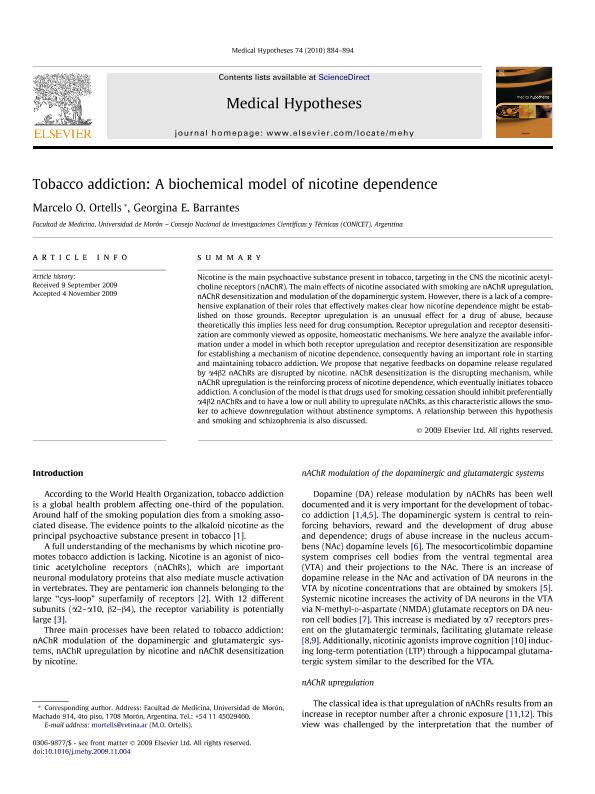Mostrar el registro sencillo del ítem
dc.contributor.author
Ortells, Marcelo Oscar

dc.contributor.author
Barrantes, Georgina Elida

dc.date.available
2023-03-23T12:44:28Z
dc.date.issued
2010-05
dc.identifier.citation
Ortells, Marcelo Oscar; Barrantes, Georgina Elida; Tobacco addiction: a biochemical model of nicotine dependence; Elsevier; Medical Hypotheses; 74; 5; 5-2010; 884-894
dc.identifier.issn
0306-9877
dc.identifier.uri
http://hdl.handle.net/11336/191551
dc.description.abstract
Nicotine is the main psychoactive substance present in tobacco, targeting in the CNS the nicotinic acetylcholine receptors (nAChR). The main effects of nicotine associated with smoking are nAChR upregulation, nAChR desensitization and modulation of the dopaminergic system. However, there is a lack of a comprehensive explanation of their roles that effectively makes clear how nicotine dependence might be established on those grounds. Receptor upregulation is an unusual effect for a drug of abuse, because theoretically this implies less need for drug consumption. Receptor upregulation and receptor desensitization are commonly viewed as opposite, homeostatic mechanisms. We here analyze the available information under a model in which both receptor upregulation and receptor desensitization are responsible for establishing a mechanism of nicotine dependence, consequently having an important role in starting and maintaining tobacco addiction. We propose that negative feedbacks on dopamine release regulated by α4β2 nAChRs are disrupted by nicotine. nAChR desensitization is the disrupting mechanism, while nAChR upregulation is the reinforcing process of nicotine dependence, which eventually initiates tobacco addiction. A conclusion of the model is that drugs used for smoking cessation should inhibit preferentially α4β2 nAChRs and to have a low or null ability to upregulate nAChRs, as this characteristic allows the smoker to achieve downregulation without abstinence symptoms. A relationship between this hypothesis and smoking and schizophrenia is also discussed.
dc.format
application/pdf
dc.language.iso
eng
dc.publisher
Elsevier

dc.rights
info:eu-repo/semantics/openAccess
dc.rights.uri
https://creativecommons.org/licenses/by-nc-sa/2.5/ar/
dc.subject
SMOKING ADDICTION
dc.subject
NICOTINE DEPENDENCE
dc.subject
SCHIZOPHRENIA
dc.subject
NICOTINIC RECEPTORS
dc.subject
UPREGULATION
dc.subject.classification
Bioquímica y Biología Molecular

dc.subject.classification
Ciencias Biológicas

dc.subject.classification
CIENCIAS NATURALES Y EXACTAS

dc.title
Tobacco addiction: a biochemical model of nicotine dependence
dc.type
info:eu-repo/semantics/article
dc.type
info:ar-repo/semantics/artículo
dc.type
info:eu-repo/semantics/publishedVersion
dc.date.updated
2023-03-22T17:41:25Z
dc.journal.volume
74
dc.journal.number
5
dc.journal.pagination
884-894
dc.journal.pais
Países Bajos

dc.journal.ciudad
Amsterdam
dc.description.fil
Fil: Ortells, Marcelo Oscar. Consejo Nacional de Investigaciones Científicas y Técnicas; Argentina. Universidad de Morón; Argentina
dc.description.fil
Fil: Barrantes, Georgina Elida. Consejo Nacional de Investigaciones Científicas y Técnicas; Argentina. Universidad de Morón; Argentina
dc.journal.title
Medical Hypotheses

dc.relation.alternativeid
info:eu-repo/semantics/altIdentifier/url/https://www.sciencedirect.com/science/article/pii/S0306987709007610
dc.relation.alternativeid
info:eu-repo/semantics/altIdentifier/doi/http://dx.doi.org/10.1016/j.mehy.2009.11.004
Archivos asociados
